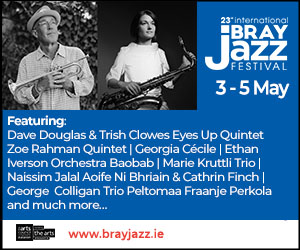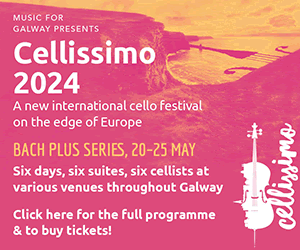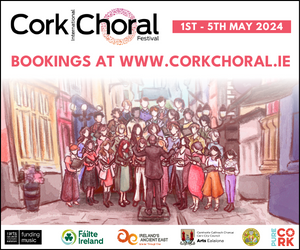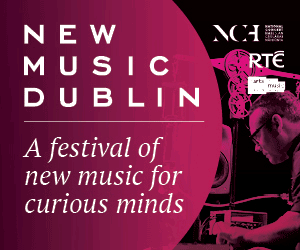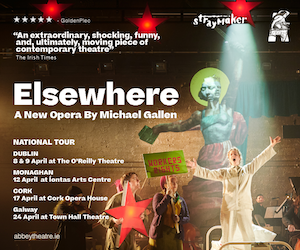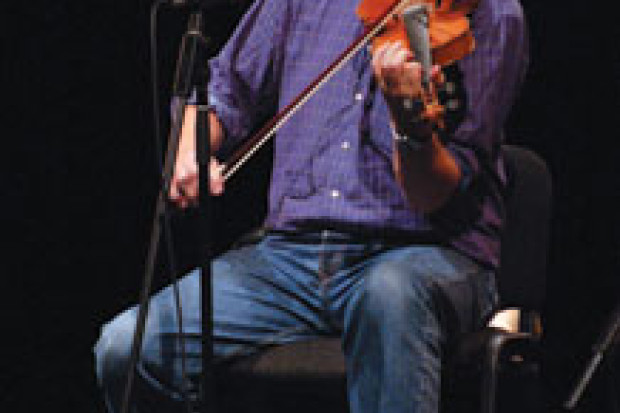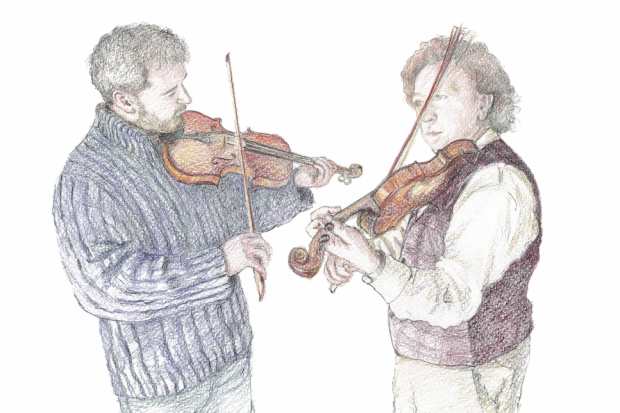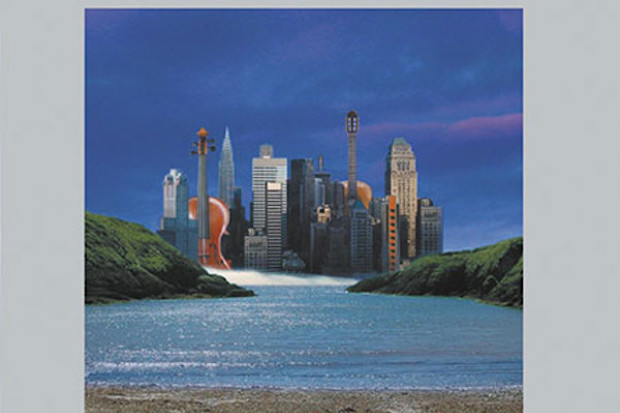The Myth of Traditional Music's Popularity
The following is based on a paper that was read to the American Conference for Irish Studies in Philadelphia in 1995. My initial concern, at the time that this was written, was that the everyday experience of the traditional music performer was radically different to the impression given via the media about the role and position that traditional music enjoyed in mid-1990s Ireland. At the time, as lecturer in traditional music at the Waterford Regional Technical College (now Waterford I.T.), I had the opportunity to try and show that the performer’s perception was not imaginary. In retrospect, I think the findings of this study were not only true at the time, but that the situation has certainly not improved in the six years under the aegis of the ‘Celtic Tiger’.
The idea that Irish music (for which, read Irish traditional music, traditional music, and folk music, as often interchangeable terms) is perceived as being a popular form is widespread via both the print and electronic media. The development in recent years of music that uses some elements of traditional music in forms that are otherwise basically commercially driven has been no small factor in reinforcing this perception.
I intend, however, to choose another expression of this claimed popularity as one of the bases of this paper. In 1983, the Arts Council published the results of a survey, commissioned by them and carried out by Lansdowne Market Research, entitled Audiences, Acquisitions, and Amateurs, and subtitled in part: A Survey into Participation in the Arts in Ireland. This survey attempted to discover behaviour patterns among the general public in three main areas:
1. Attendance at arts events
2. Purchase of arts goods
3. Amateur artistic activity
Although the results of this survey are of general interest to anyone involved in the arts in Ireland, only those relevant to traditional music are dealt with here. The first question asked respondents if they had attended an arts event in various past periods ranging from 2 years to 6 months, with the following choice of answer: a play, a classical music performance, a popular music performance, an exhibition of paintings or sculptures by living artists, a performance of traditional music, or dance, a ballet, a film.
Regarding attendance, the results showed that after film (37%), attendance at a performance of traditional music (21%) was the next most popular, with plays 20%, pop music 17%, classical music 9%, art exhibition 8% and ballet 5%, following in that order. The figures are further broken down in terms of age groups and regions, which are outside my remit here.
In the second category, ‘Purchase of Arts Goods’, the results were: records/tapes of traditional music 23%, novels/poetry/plays by living authors 15%, recordings of classical music 10%, paintings/sculptures by living artists 2%.
The remarkable thing about these figures, for those who are familiar with the Irish scene, is the very high profile that traditional music is seen to have, as revealed in the first two categories. Most traditional musicians of my acquaintance were openly dismissive of this result. Their experience had been otherwise.
One body, however, Comhaltas Ceoltóirí Éireann, took the figures at face value, and used them to support the idea that the role that they claim within the community, that of the main promoters/facilitators/representatives of traditional music in Ireland, was indeed having effect, and that this was reflected in the large public awareness and participation in the art form. They tried to use the results to increase their grant aid from the Arts Council, which had been cut back some time before, but were informed that if traditional music was indeed so popular then other art forms stood more in need of Arts Council support.
The fact remained that musicians and those close to traditional music activity in Ireland felt let down by this report, which seemed to reveal a society very different to the one in which they were trying to practise their art.
I was aware of this study both as a practising musician and later on as an academic when I actually read it in detail and debated how representative it was of the situation in Ireland in 1981. (The survey was carried out between 27 February and 6 March 1981). Several things sprang to mind as being suspect apart from the way in which it portrayed traditional music. For example, the figures quoted for attendance at ballet was 5%. About right you might initially think, ballet being a minority interest art form. But taking the population of the Republic of Ireland in 1981 at a rough figure of 3.5 million this 5% implies that 175,00 people saw a ballet in 1981, a patently unsupportable statistic. Studying the report, I came to the conclusion that the basic problem lay in the form of the questionnaire, always a bugbear for social surveys of this kind. The authors themselves foresaw this to some extent by claiming in the introduction: ‘We can be confident that the responses are an accurate reflection of the attitudes and reported behaviour of the population at the time of interviewing’ (their italics) p. 4.
The form of the questionnaire, alluded to earlier, gave a limited choice to the respondents, naming types of arts events, classical music, film, traditional music, etc., so in other words the respondents themselves were allowed to classify what they thought each of these categories entailed. My own experience had taught me that in fact the general public had an exceptionally wide definition of traditional music, so it is here that the flaw lies in this study.
But was it in fact flawed, or were the musicians on the ground so out of touch with reality? What was needed was another study essentially in the same area but putting the questions in such a way to avoid this self-definition.
An opportunity to do this arose when from 1992 to 1995 I was traditional music lecturer in the music department of Waterford Regional Technical College, and as part of my duties I assigned projects in which all students participated. Early in 1994 I hit on the idea of carrying out a local survey in the city of Waterford with the aid of the students that would reveal something of the attitudes to traditional music. The design of the questionnaire was discussed over a long period of time, and there was a large degree of student involvement in this. The questionnaire was not to suggest categories to the respondent, and the design entailed that the respondents were allowed to suggest their own definitions.
During the year we had discussed the history and development of traditional music in Ireland and it was decided that we should attempt to get some indication of the level of awareness of the core dance music tradition, by which was meant the pre-revival, non-commercial, solo tradition. The following format was decided: a person, well known to all who are involved in such music, would be named and the respondent would simply be asked ‘Who is X?’ This question would, if answered correctly, then lead to others, without any suggestions from the questionnaire as to what might be possible answers. No lists or choices were given to the respondents. The final form of the questionnaire was as follows:
1. Who is Seamus Ennis? [to which the two possible responses were]
(a) Musician [the correct answer].
(b) Don’t know or an incorrect response.
2. What instrument does he play? [again with two possible responses]
(a) Pipes
(b) Don’t know/wrong instrument
3. Do you Listen to traditional music?
Yes/No
4. Give an Example.
5. Have you bought a traditional recording in the last year?
Yes/No
6. Give an Example
The respondents were classified into the under-25, 25–50, and over-50 age groups on the opinion of the questioner.
The choice of Seamus Ennis as the person identified with the particular area of traditional music that we sought to identify was to some extent arbitrary, and in fact the name Willie Clancy was at first proposed as being more generally recognisable. It was rejected, however, because of confusion that appeared in a test run where, due to local associations, there was some confusion with one or other of the Clancy Brothers!
The results of this survey, although not designed to be a direct re-test of the Arts Council study, do in fact suggest that the measure of involvement with traditional music suggested by the latter is certainly not in the area of the core dance music tradition.
They can be summarised as follows: The sample size was 295, of whom 134 were estimated to be under 25 years, 95 between 25 and 50 years, and 66 over 50 years of age. Age group divisions below are shown as a percentage of the overall sample.
1. The % who claimed to know Ennis was a musician:
overall: 41.35%
under-25: 14.57%
25–50: 13.89%
over-50: 11.86%
2. The number of people who knew Ennis was a musician but who also claimed that they never listened to traditional music.
overall: 9.15%
under-25: 3.38%
25–50: 3.05%
over-50: 2.37%
3. Conversely, there was also a group who didn’t know who Ennis was, but claimed to listen to traditional music.
overall: 25.42%.
under-25: 11.52%
25–50: 8.13%
over-50: 5.42%
4. The % who also knew what instrument Ennis played.
overall: 24.06%
under-25: 6.10%
25–50: 9.493%
over-50: 7.79%
5. The % who claimed to listen to traditional music:
overall: 57.62%
under-25: 22.71%
25–50: 18.98%
over-50: 14.91%
6. The % who bought a traditional recording:
overall: 22.03%
under-25: 9.83%
25–50: 8.47%
over-50: 3.72%
So far these results certainly seem to be in the same general area as those of the 1983 survey. For example, in the one area of direct comparison, that of recording purchase, the Arts Council survey reported 23% had bought a recording in the last year, whereas the Waterford results indicate 22.03%, which could hardly be much closer. The numbers who claim to listen to traditional music as revealed here, in fact seem to strongly reinforce the position of traditional music as the most ‘popular’ form in the country. However, questions 4 and 6, which required the respondents to give an example of the type of traditional music they listened to or bought tell a very different story, and demonstrate how misleading it can be to allow respondents in such a survey define for themselves the very area under investigation. The 170 respondents who claimed to listen to traditional music gave the names of 45 different individual performers or groups of performers. 14 gave more general answers, naming a type of instrument or performance genre. Of these 45, 29 merited a single mention, 13 between 2 and 10, and only 3 over 10, of whom 2 were completely dominant. It was decided to classify the performers into the following groups:
1. Solo ‘core’ performers
2. Commercial traditional performers
3. Céilí Band
4. Ballad performers
5. Non-traditional performers
This type of classification must by necessity be somewhat crude, since there is a degree of overlap between some of the categories, but none the less the figures are quite convincing.
1. Solo ‘core’ performers
5.88%
2. Commercial traditional performers 52.35%
3. Céilí bands 1.17%
4. Ballad performers 20.58%
5. Non traditional performers 4.7%
The figure for group 2, commercial traditional performers, must be further broken down since in fact, of this 52%, 33% is accounted for by only two performers, The Chieftains making up 17.64%, and Sharon Shannon 15.88%.
In terms of recordings purchased, 65 of the 170 who claimed to listen to traditional music claimed to have purchased a recording in the year previous to the questionnaire. When asked to give an example of such a purchase, 23 different performers were named, and when broken down into the same categories the results were as follows:
1. Solo ‘core’ performers: 4.61% 2. Ballad performers: 13.84%
3. Commercial traditional performers: 55.38%
4. Non traditional performers: 40%
5. Céilí bands: 0%
The uneven distribution amongst performers here is even more noticeable, with 44.61% of all recordings purchased coming from only two performers, or more correctly one performer and a compilation recording, Sharon Shannon accounting for 21.53% of all recordings purchased (above classified under commercial traditional) and the compilation recording A Woman’s Heart, which features a selection of contemporary Irish female performers, and since it consists almost entirely of contemporary or MOR material, is classified as non-traditional.
There is no doubt that music perceived by the public as being traditional forms a large part of both the listening and purchasing that they claim to practise. In these terms, this survey backs up the results of the Arts Council survey. The fact that the level of record purchases in the perceived traditional field is revealed as almost identical in both surveys seems to indicate a consistent level of public interest since 1983.
The essence of the present results I feel lies in the demonstration that a very wide range of music is grouped by the public under the heading ‘traditional’, ranging from modern contemporary singer songwriters, through country music, to the closer fields of ballad groups to commercial traditional performers, and finally to solo core traditional performers, the awareness of whom this survey was designed to measure. The level of awareness of this last group, 5.88%, is certainly much more in line with the experience of traditional musicians on the ground, than the 21% suggested by the Arts Council survey. The much larger figure quoted in the Arts Council survey in terms of participation in traditional music can now be explained by the inclusion of music types with varying degrees of relationship to core traditional music. Purchases of traditional recordings show the same trends, but it could be claimed that the level of public misconception about traditional music is even more obvious here, with a massive 40% of the purchases classified as non-traditional, and the purchases of core recordings at around a tenth of this figure. It should be noted that the two recordings mentioned above are both very recent commercial successes.
Obviously the conclusions that are drawn here depend very much on the definition of the word traditional, and in fact the answers given to the questionnaire reveal that in the public mind at least, this can be very broad. However, the active definition adopted here is that generally accepted by the large number of amateur, semi-professional, and professional performers of dance music and the associated body of song, and I have no hesitation in claiming that this opinion is representative, having been an active part of this group for thirty years.
It must also be remembered that the survey only claims to represent the opinions of the people in the city of Waterford, which would be a typical large town/small city in the east of Ireland. Different results might be obtained in other places, and I think that, for example, the same survey carried out in some rural areas of the west might reveal a higher awareness of the core tradition. However, if any one major conclusion can be drawn from this work it is that the public, media-fed notion that traditional music is currently a highly popular form is in fact a myth, and in fact the converse view, held by most of the participants/musicians, that it is the interest of a small minority, is much closer to the truth.
Looking back on this survey some seven years later I think that most traditional performers would agree that the situation as described still prevails. Many musicians that are playing regularly complain that no one listens to their music. The public like the idea of traditional music, they like it to to be there as a form of musical wall paper, but only a tiny group, mainly, I would argue, consisting of the musicians themselves, have a real aesthetic understanding and appreciation of the dance music tradition. What this means in terms of the development and survival of the music is a topic that I hope to follow in future research and publications.
Published on 1 May 2001
Dr Hammy Hamilton has been a professional flutemaker since 1979. He taught Irish music at UCC and WIT, and was a Fulbright scholar at UCLA. Currently he is an independent academic, living and working in the West Cork gaeltacht. He is the author of The Irish Fluteplayer's Handbook.







